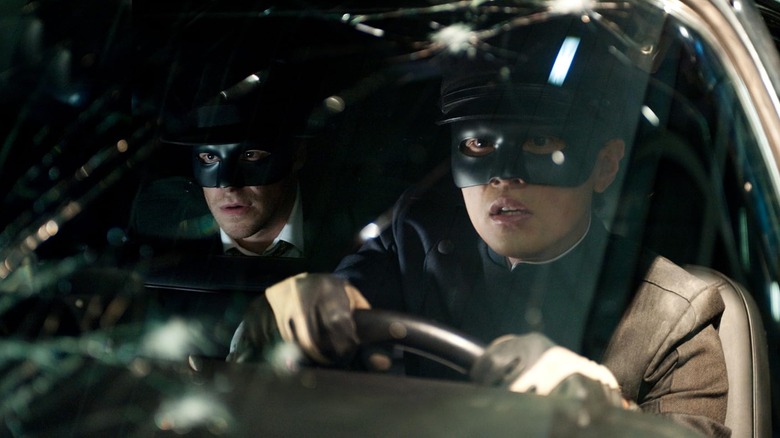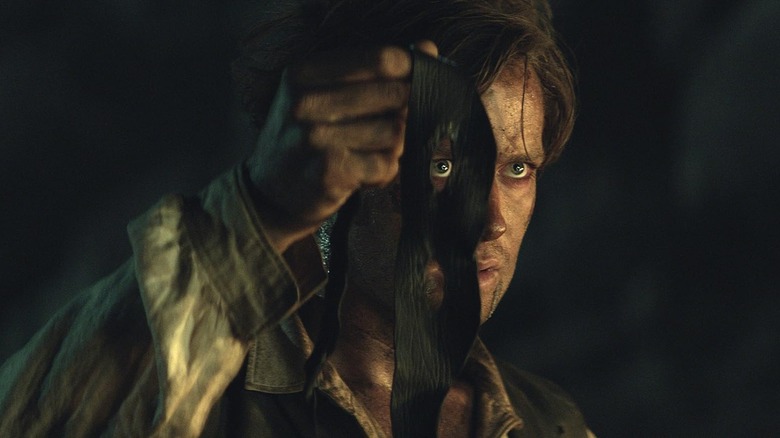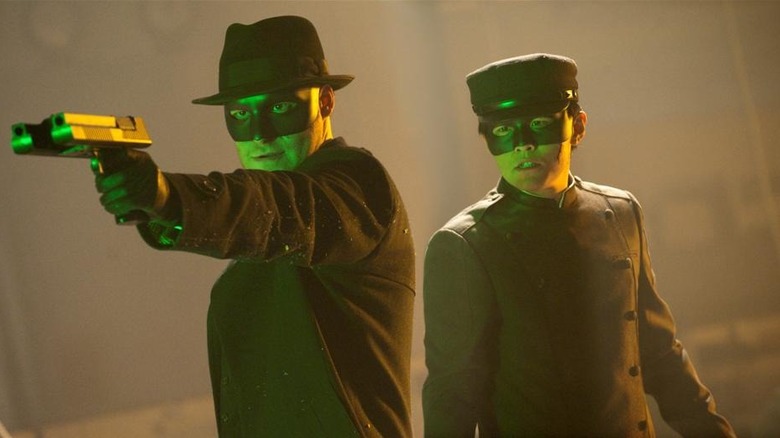Are The Lone Ranger And The Green Hornet Connected?
The Lone Ranger isn't terrible popular among newer generations — the spectacular failure of the 2013 "Lone Ranger" feature film cemented that notion — but for many Baby Boomers, the character is a vital pop culture figure. For those who may need a refresher, The Lone Ranger is a masked vigilante who toured the Old West with his Indigenous American compatriot Tonto, writing wrongs on a freelance basis. He was previously a Texas Ranger (hence his moniker), rode a horse named Silver, and dispatched bad guys with specially made silver bullets.
The Lone Ranger first appeared as the protagonist of a 1933 radio serial co-created by Fran Striker and George W. Trendle, which broadcasted on WXYZ out of Detroit, Michigan. This radio show was popular enough to warrant a "Lone Ranger" TV series, which is what really thrust the titular character into the pop culture zeitgeist as it ran for 221 episodes over nine years. Clayton Moore played the Lone Ranger for the bulk of the show (save for a strange hiatus when John Hart took over), with Jay Silverheels also starring as Tonto.
Like the Lone Ranger, the superhero Green Hornet — also created by Striker and Trendle — debuted on WXYZ, this time in 1936. The Green Hornet, in contrast to the Lone Ranger, was a modern-day figure who used high-tech gadgets to foil the plans of urban villains. Similarly, instead of riding a horse, the Green Hornet rode around in a heavily-equipped, super-awesome car nicknamed the Black Beauty. He did, however, wear a domino mask to engage in crimefighting activities just like the Lone Ranger and had his own sidekick, Kato, to boot.
In 1966, after the success of the live-action "Batman" TV show, ABC made a "Greet Hornet" series that cemented the Green Hornet and Kato's place in the pop culture consciousness (with Van Williams playing the Hornet and Bruce Lee portraying Kato). Not only that, the Green Hornet is also, canonically, the great-nephew of the Lone Ranger.
The Green Hornet is the Lone Ranger's great-nephew
The origin story of the Lone Ranger is typical superhero fodder. The legend goes that six stalwart Texas Rangers, led by the heroic Captain Dan Reid, were out in the wilds of the Old West, seeking the dangerous criminal Butch Cavendish. Unexpectedly, Cavendish got the drop on them, killing them all. Later, when Tonto came upon the aftermath of the murders, he found that Dan Reid's younger brother, John, was still alive. After being nursed back to health by Tonto, John then decided to become a lone vigilante in order to seek justice, fashioning his mask out of his dead brother's vest.
As it so happens, the Green Hornet's real name is Britt Reid. Britt was the son of a wealthy newspaper owner, and eventually inherited the paper himself. Using his media wealth, he built his high-tech crimefighting gadgets and infiltrated the urban underground to root out mob bosses and the like. The Police hated the Green Hornet, thinking he was merely another criminal. This was in contrast to Batman, who worked with the police.
In the original "Green Hornet" radio show (specifically in the 1947 episode "Too Hot to Handle"), it's clearly established that Britt's wealthy father is Dan Reid Jr., the son of the Lone Ranger's dead older brother. Dan Reid Jr. also had a recurring role on the original "Lone Ranger" radio serials, serving as his uncle John's teen sidekick. He would grow up to have a son named Britt, who was portrayed as an adult by John Todd on the "Green Hornet" radio series. (Todd also played Tonto on the original "Lone Ranger" radio show.)
Hence, Britt Reid, the Green Hornet, is canonically the grandson of the Lone Ranger's brother.
The Green Hornet launched a shared superhero universe before Marvel and DC
The connection between the Lone Ranger and the Green Hornet may be the earliest example — or at least one of the first — of a shared superhero universe. Such a concept may feel natural and expected to modern audiences, but it wasn't always common. Superman, for instance, debuted in Action Comics #1 in 1938, while Batman first appeared in Detective Comics #27 in May 1939. However, the two wouldn't meet face-to-face until All-Star Comics #1 in 1941. Likewise, Marvel introduced its characters the Sub-Mariner and the Human Torch in Marvel Comics #1 1939, but the pair wouldn't meet in person until Marvel Mystery Comics #9 in 1940.
Since then, it's become customary for comic book characters owned by the same company to exist in a share universe. They still have their own solo adventures, but can, at the writers' whims, interact with one another in crossover stories. Over the decades, the notion of a shared universe gradually evolved into the bread-and-butter of both DC Comics and Marvel Comics. It also became equally fashionable in Hollywood for a period after the Marvel Cinematic Universe kicked off with "Iron Man" in 2008.
Because the Green Hornet debuted in 1936, however, it beat out Marvel and DC to the "shared universe" punch by several years. Two star superhero characters were not only in the same universe, but were also related, separated only by a generation. Because of the time differential, the Lone Ranger and the Green Hornet never interacted, although the two heroes stood out as an example of familial legacy. A hero in one century would, by their righteous actions, inspire heroism in the next. There's something glorious about that.


